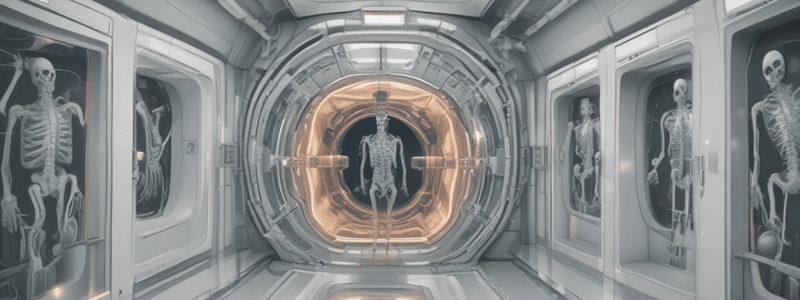Podcast
Questions and Answers
What characterizes First-generation CT systems?
What characterizes First-generation CT systems?
- Multiple X-ray sources
- Rotating X-ray source and detector
- Stationary X-ray source and detector
- Single X-ray source (pencil beam or parallel-beam geometry) (correct)
What happens during the scan process in First-generation CT systems?
What happens during the scan process in First-generation CT systems?
- The source and detector move in opposite directions
- The source translates in a linear motion across the patient (correct)
- The detector is stationary and the source moves in a circular motion
- The source and detector rotate simultaneously in a scan plane
What is an advantage of First-generation CT systems?
What is an advantage of First-generation CT systems?
- Low cost
- Ability to scan entire body
- Flexibility in the choice of scan parameters (correct)
- Fast scan time
What is a limitation of First-generation CT systems?
What is a limitation of First-generation CT systems?
What is generated during the operation of First-generation CT systems?
What is generated during the operation of First-generation CT systems?
What type of scans can be performed using First-generation CT systems?
What type of scans can be performed using First-generation CT systems?
Flashcards are hidden until you start studying
Study Notes
First-Generation CT Systems
- Characterized by single X-ray source with parallel-beam geometry
- Uses a single highly collimated X-ray pencil beam and detector directed across the patient isocenter
- Multiple measurements of X-ray transmission obtained by translating X-ray source and detector simultaneously in a scan plane
- Beam translated in a linear motion across the patient to obtain a projection profile
- Process repeated for a given number of angular rotations (approximately 1 degree) until source and detector rotated by 180 degrees
- Advantages:
- Simplicity
- Good view-to-view detector matching
- Flexibility in choosing scan parameters (resolution and contrast)
- Highly collimated beam provides excellent rejection of scattered radiation
- Limitations:
- Only head scans can be performed
- Generates a lot of heat, requiring elaborate cooling system
- Scan time is very slow (about 1 minute per slice, averaging 25-30 minutes per scan)
Studying That Suits You
Use AI to generate personalized quizzes and flashcards to suit your learning preferences.




